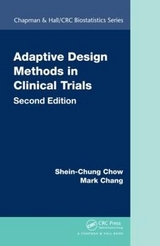
Adaptive Design Methods in Clinical Trials
Chapman & Hall/CRC (Verlag)
978-1-58488-776-8 (ISBN)
- Titel erscheint in neuer Auflage
- Artikel merken
Although adaptive design methods are flexible and useful in clinical research, little or no regulatory guidelines are available. One of the first books on the topic, Adaptive Design Methods in Clinical Trials presents the principles and methodologies in adaptive design and analysis that pertain to adaptations made to trial or statistical procedures that are based on accrued data of ongoing clinical trials. The book also offers a well-balanced summary of current regulatory perspectives and recently developed statistical methods in this area.
After an introduction to basic concepts and statistical considerations of adaptive design methods, the book questions the impact on target patient populations as the result of protocol amendments and discusses the generalization of statistical inference. The authors also present various adaptive design methods, including where hypotheses are modified during the conduct of clinical trials, for dose selection, and commonly used adaptive group sequential design methods in clinical trials. Following a discussion of blind procedures for sample size re-estimation, the book describes statistical tests for seamless phase II/III adaptive designs and statistical inference for switching adaptively from one treatment to another. The book concludes with computer simulations and various case studies of clinical trials.
By providing theoretical and computer simulation results, method comparisons, and practical guidelines for choosing an optimal design, Adaptive Design Methods in Clinical Trials fills the need for a unified, comprehensive, and updated resource in the clinical research and development of adaptive design and analysis.
INTRODUCTION
What Is Adaptive Design
Regulatory Perspectives
Target Patient Population
Statistical Inference
Practical Issues
Aims and Scope of the Book
PROTOCOL AMENDMENT
Actual Patient Population
Estimation of Shift and Scale Parameters
Statistical Inference
Sample Size Adjustment
Statistical Inference with Covariate Adjustment
Concluding Remarks
ADAPTIVE RANDOMIZATION
Conventional Randomization
Treatment-Adaptive Randomization
Covariate-Adaptive Randomization
Response-Adaptive Randomization
Issues with Adaptive Randomization
Summary
ADAPTIVE HYPOTHESES
Modifications of Hypotheses
Switch from Superiority to Noninferiority
Concluding Remarks
ADAPTIVE DOSE-ESCALATION TRIALS
Introduction
CRM in Phase I Oncology Study
Hybrid Frequentist-Bayesian Adaptive Design
Simulations
Concluding Remarks
ADAPTIVE GROUP SEQUENTIAL DESIGN
Sequential Methods
General Approach for Group Sequential Design
Early Stopping Boundaries
Alpha Spending Function
Group Sequential Design Based on Independent P-Values
Calculation of Stopping Boundaries
Group Sequential Trial Monitoring
Conditional Power
Practical Issues
ADAPTIVE SAMPLE SIZE ADJUSTMENT
Sample Size Re-Estimation without Unblinding Data
Cui-Hung-Wang's Method
Proschan-Hunsberger's Method
Muller-Schafer Method
Bauer-Köhne Method
Generalization of Independent P-Value Approaches
Inverse-Normal Method
Concluding Remarks
ADAPTIVE SEAMLESS PHASE II/III DESIGN
Why a Seamless Design Is Efficient
Step-wise Test and Adaptive Procedures
Contrast Test and Naive P-Value
Comparisons of Seamless Design
Drop-the-Loser Adaptive Design
Summary
ADAPTIVE TREATMENT SWITCHING
Latent Event Times
Proportional Hazard Model with Latent Hazard Rate
Mixed Exponential Model
Concluding Remarks
BAYESIAN APPROACH
Basic Concepts of Bayesian Approach
Multiple-Stage Design for Single-Arm Trial
Bayesian Optimal Adaptive Designs
Concluding Remarks
CLINICAL TRIAL SIMULATION
Simulation Framework
Early Phases Development
Late Phases Development
Software Application
Examples
Concluding Remarks
CASE STUDIES
Basic Considerations
Adaptive Group Sequential Design
Adaptive Dose-Escalation Design
Adaptive Seamless Phase II/III Design
SUBJECT INDEX
BIBLIOGRAPHY
| Erscheint lt. Verlag | 16.11.2006 |
|---|---|
| Reihe/Serie | Chapman & Hall/CRC Biostatistics Series |
| Zusatzinfo | 1000 equations; 56 Tables, black and white; 21 Illustrations, black and white |
| Sprache | englisch |
| Maße | 152 x 229 mm |
| Gewicht | 522 g |
| Themenwelt | Medizin / Pharmazie ► Medizinische Fachgebiete ► Pharmakologie / Pharmakotherapie |
| Medizin / Pharmazie ► Pharmazie ► Pharmazie Studium | |
| ISBN-10 | 1-58488-776-1 / 1584887761 |
| ISBN-13 | 978-1-58488-776-8 / 9781584887768 |
| Zustand | Neuware |
| Informationen gemäß Produktsicherheitsverordnung (GPSR) | |
| Haben Sie eine Frage zum Produkt? |
aus dem Bereich



